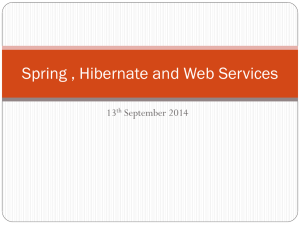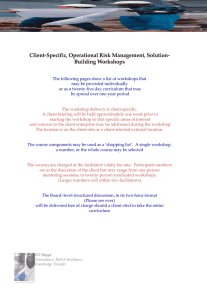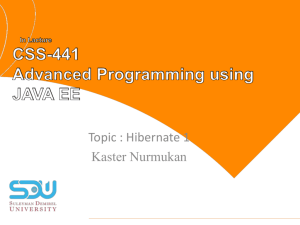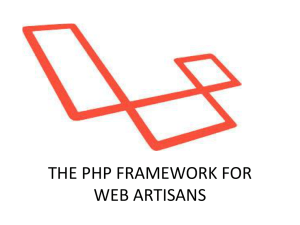How does Metaprogramming affect software flexibility in Object-Relational Mapping
advertisement
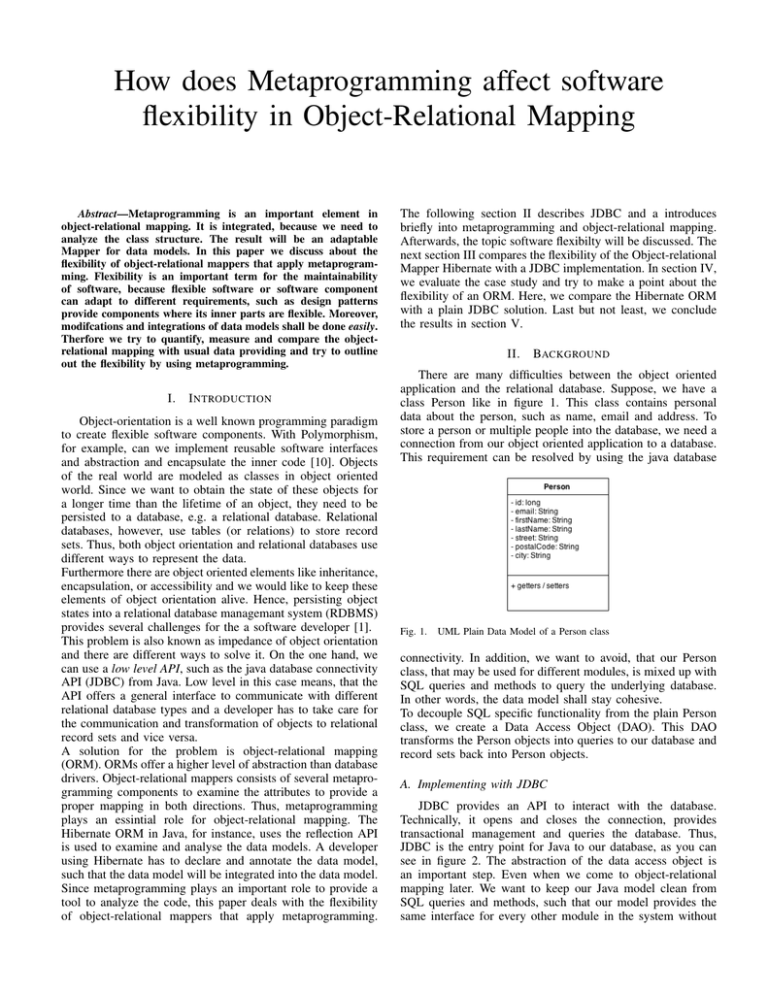
How does Metaprogramming affect software
flexibility in Object-Relational Mapping
Abstract—Metaprogramming is an important element in
object-relational mapping. It is integrated, because we need to
analyze the class structure. The result will be an adaptable
Mapper for data models. In this paper we discuss about the
flexibility of object-relational mappers that apply metaprogramming. Flexibility is an important term for the maintainability
of software, because flexible software or software component
can adapt to different requirements, such as design patterns
provide components where its inner parts are flexible. Moreover,
modifcations and integrations of data models shall be done easily.
Therfore we try to quantify, measure and compare the objectrelational mapping with usual data providing and try to outline
out the flexibility by using metaprogramming.
I.
I NTRODUCTION
Object-orientation is a well known programming paradigm
to create flexible software components. With Polymorphism,
for example, can we implement reusable software interfaces
and abstraction and encapsulate the inner code [10]. Objects
of the real world are modeled as classes in object oriented
world. Since we want to obtain the state of these objects for
a longer time than the lifetime of an object, they need to be
persisted to a database, e.g. a relational database. Relational
databases, however, use tables (or relations) to store record
sets. Thus, both object orientation and relational databases use
different ways to represent the data.
Furthermore there are object oriented elements like inheritance,
encapsulation, or accessibility and we would like to keep these
elements of object orientation alive. Hence, persisting object
states into a relational database managemant system (RDBMS)
provides several challenges for the a software developer [1].
This problem is also known as impedance of object orientation
and there are different ways to solve it. On the one hand, we
can use a low level API, such as the java database connectivity
API (JDBC) from Java. Low level in this case means, that the
API offers a general interface to communicate with different
relational database types and a developer has to take care for
the communication and transformation of objects to relational
record sets and vice versa.
A solution for the problem is object-relational mapping
(ORM). ORMs offer a higher level of abstraction than database
drivers. Object-relational mappers consists of several metaprogramming components to examine the attributes to provide a
proper mapping in both directions. Thus, metaprogramming
plays an essintial role for object-relational mapping. The
Hibernate ORM in Java, for instance, uses the reflection API
is used to examine and analyse the data models. A developer
using Hibernate has to declare and annotate the data model,
such that the data model will be integrated into the data model.
Since metaprogramming plays an important role to provide a
tool to analyze the code, this paper deals with the flexibility
of object-relational mappers that apply metaprogramming.
The following section II describes JDBC and a introduces
briefly into metaprogramming and object-relational mapping.
Afterwards, the topic software flexibilty will be discussed. The
next section III compares the flexibility of the Object-relational
Mapper Hibernate with a JDBC implementation. In section IV,
we evaluate the case study and try to make a point about the
flexibility of an ORM. Here, we compare the Hibernate ORM
with a plain JDBC solution. Last but not least, we conclude
the results in section V.
II.
BACKGROUND
There are many difficulties between the object oriented
application and the relational database. Suppose, we have a
class Person like in figure 1. This class contains personal
data about the person, such as name, email and address. To
store a person or multiple people into the database, we need a
connection from our object oriented application to a database.
This requirement can be resolved by using the java database
Fig. 1.
UML Plain Data Model of a Person class
connectivity. In addition, we want to avoid, that our Person
class, that may be used for different modules, is mixed up with
SQL queries and methods to query the underlying database.
In other words, the data model shall stay cohesive.
To decouple SQL specific functionality from the plain Person
class, we create a Data Access Object (DAO). This DAO
transforms the Person objects into queries to our database and
record sets back into Person objects.
A. Implementing with JDBC
JDBC provides an API to interact with the database.
Technically, it opens and closes the connection, provides
transactional management and queries the database. Thus,
JDBC is the entry point for Java to our database, as you can
see in figure 2. The abstraction of the data access object is
an important step. Even when we come to object-relational
mapping later. We want to keep our Java model clean from
SQL queries and methods, such that our model provides the
same interface for every other module in the system without
...
}
Listing 1.
Fig. 2.
Layered architecture of plain JDBC
any smudgy functionality. Assume, you would pack all the
code of a DAO into your model. Your class may become very
large, because you have to take into account that there there
can be different kind to query your data model, e.g. you need
to query all people, you need to count people with first name
Max and you need to create, update or delete a single person.
A create method for a single person in a DAO can look like in
listing 1. We have a predefined SQL statement for the creation.
This statement contains all attributes, except the personal id.
The question marks in the end are replaced by a call of a
prepared statement. The developer has to take into account,
that parameter have to be in the same order as listed in the
SQL statement.
public class PersonDAOJDBC implements IPersonDAO {
...
private static final String SQL_CREATE =
"INSERT INTO Person (email, firstName, lastName, ...) VALUES
(?, ?, ?, ...)";
...
public void create(Person person) {
// set values as parameters for prepared statement
Object[] values = {
person.getEmail(),
// ... further values
};
Method to create record set for a Person object
Assume, an attribute name of a class and a column name of
a relation shall store the same values but have an inconsistent
naming for those, e.g. firstName is the attribute name and
first name is the name of the column. Consequently, we have
to take this into account for every query and backtransformation in JDBC.
Consider now, you have many data models. To query your
database you probably have a lot of DAOs to access the data
of these objects. First, you would have to copy the database
operations into every DAO. Thereby, we have to copy and
paste a lot of code and modify it afterwards. This also contain
the risk to generate error prone code or to forget an attribute
mapping. Second, if there are many inconsistencies, you would
have to modify it for every DAO with respect to its SQL
statement and the backtransformation, too.
Metaprogramming, such as the Java Reflection API, can be
used to tackle this problem. During this section we will
introduce into metaprogramming and how it is used in objectrelational mapping.
B. Metaprogramming
Metaprogramming is used to examine, analyse and
modify the run-time behaviour of code [8]. The so called
computational reflection is established because we want to
implement adaptable and reusable software [5]. We know
that the mechanisms of object orientation are flexible enough
because we can design reusable code and design patterns help
us to create dynamic and adaptable software components [3].
Even though this is true for many use cases, we may need
information about the class of the object.
In Java, the Java Reflection API is used to inspect classes
to gather information about fields, methods and types and
modify the runtime behaviour of objects. Listing 2 shows
a little mapper. This mapper stores the type that should be
mapped in an instance attribute myClass.
try (
Connection con = daoFactory.getConnection();
PreparedStatement preStmt = prepareStatement(con,
SQL_CREATE, true, values);
)
{
// Execute create operation
int rowsAffected = preStmt.executeUpdate();
if (rowsAffected == 0) {
throw new DAOException("Creation failed! No
rows were created");
}
// Get new primary key as ID
try (ResultSet generatedKeys = preStmt.
getGeneratedKeys()) {
if (generatedKeys.next()) {
person.setId(generatedKeys.getLong(1));
}
else {
throw new SQLException("Creating user failed, no
ID obtained.");
}
} catch (SQLException e) {
throw new DAOException(e);
}
} catch (SQLException e) {
throw new DAOException(e);
}
public final class Mapper<T> {
...
private Class<T> myClass;
public Mapper(Class<T> myClass) {
this.myClass = myClass;
}
public T map(ResultSet rs) {
T instance = null;
try {
instance = myClass.newInstance();
} catch (IllegalAccessException \\
| InstantiationException ie) {
return null;
}
// attribute mapping
for (Field f : myClass.getDeclaredFields()) {
f.setAccessible(true);
try {
f.set(instance, rs.getObject(f.getName()));
} catch (SQLException sqlE) {
// field of rs not find, ignore it...
} catch (IllegalAccessException ie) {
// nothing happens
}
f.setAccessible(false);
}
return instance;
}
Listing 2.
Example Mapper with Metaprogramming
If method map with a record set is called, we try to instantiate a
object of class with type T. Thus, we need a default constructor
for our data model in order to invoke method newInstance. If
the instantiation succeeds, we try to map the attributes of the
record set to the object attributes. With this mapper we will be
able to exchange the get methods provided by the RecordSet
object as the listings 5 and 6 in section III exemplify.
Regard, that this is a simple mapper that sets the attributes of
the known type T. This mapper is neither able to manage joins
nor able to transform name inconsistencies.
C. Object-relational Mapping
Object-relational mappers, e.g. Hibernate and OpenJPA go
a bit further than our example mapper from listing 2. They
accomplish to simplify the impedance of object orientation.
Both implement the Java Persistence API (JPA) and take a lot
of use cases into account for database interaction, such as the
relationships between the data models or name inconsistencies.
The interconnection between the database and the object
oriented system is still realized by JDBC, as figure 3 illustrates.
ORMs that implement JPA have annotated data models. The
}
Listing 3.
Data Model with JPA Annotations
The ORM must know in beforehand which objects shall
be mapped. Therefore, they often have to be configured in
declarative XML files. These XML files are read before the
application starts. Hereby, the ORM knows which classes shall
be examined and integrated for the mapping process [1].
Since we have these two ways to interact with our database,
we could ask ourselves: Which solution is more flexible to a
new problem. Before we elaborate the case study in section
III, we discuss the topic software flexibility.
D. Software Flexibility
During the process of software development, new requirements and problems can occur everytime. Thus, one demand in
software engineering a flexible software design [4]. If there are
new requirements or problems, the old parts should be adapt
to the new situtation. But what is exactly flexibility? IEEE
defines software flexibility as the following:
Flexibility: The ease with which a system or
component can be modified for use in applications
or environments other than those for which it was
specifically designed [4].
This definition provides a wide range of interpretation. One
would usually say, a system or a component is flexible, if it
modifications need a low effort to implement and software
components are adaptable to new problems. Gamma et. al.
developed another definition for software flexibility in case of
software patterns:
Each design pattern lets some aspect of system structure vary independently of other aspects,
thereby making a system more robust to a particular
kind of change [3].
Fig. 3.
Layered architecture of the system with an ORM
annotations are used to set database related attributes, such
as annotation @Entity in listing 3. By setting the provided
annotations, an ORM can gather meta information about the
database. ORMs analyse the class structure and build the
mappings between relational tables and our objects. Even
though annotations extend our code, it is more decent than
whole methods would do it.
@Entity
public class Person {
@Id
@GeneratedValue(strategy = GenerationType.IDENTITY)
private long id;
...
Gamma et al. refer to rather patterns where the inner components can be modified by following the pattern structure. In
addition, the inner components are often exchangable during
runtime and thus flexible [3].
Even though both quotations show claims to software flexibility, one would rather rely on emprical aspects in software
development, such as time, knowledge and experience and
labour power.
Eden and Mens introduce in their paper another approach
and introduce the terms of evolutional step and cost metric
functions for software flexibility [2]. A contribution to describe
software flexibilty provides the software complexity notation,
the O notation. To distinguish between a current step and a
future step in the process of software development, Eden and
Mens define the term evolutional step.
1) Evolutional Step: Every software consists of a set
of function and non-functional requirements. Those can be
abstracted as problem. In addition, software development
is an evolutionary process where modifications affect the
implementation [2].
To distinguish between changes of problem and
implementation, modifications of problems are called
shifts and modifications in the implementation are called
adjustements. A shifted problem and following adjusted
implementation are called evolution step of software [2].
According to Eden and Mens, a evolutional step is defined as
a function:
Definition 1: Evolution function is a functional
relation E such that:
E := P×P×I and E(pold , pshif ted , iold ) = iadjusted
only if iold realizes pold and iadjusted realizes
pshif ted
An evolution step is a pair
= ((pold , pshif t , iold ), E((pold , pshif t , iold )) [2]
line counts as added code. This could be done trivially by the
following equation.
LoC(m) When counts to the new module
Add/LoC(m) ≈
0
otherwise
By using the evolutional step and the cost metric function,
we can define software flexibility O. Eden and Mens call a
old implementation flexible if there is a constant growth of
the affected classes. If there is a linear growth the software
count as rather inflexible. In contrast, if we achieve a constant
growth, the old software components are more flexible.
1 implementation is flexible
O(C()) =
n implementation is inflexible
In other words, consider, you have an old implementation
iold that relies on problem pold . Once, you will get a new
requirement. This requirement can be seen as problem pshif ted .
Consequently, an implementation iadjusted would be an evolutional step according to Eden and Mens. Let us recapitulate
our example from the introduction. We have a persistable class
Person.
In other words, if a mofification is needed, there will be
less lines to add. In contrast, when you change a interface
specification by adding or changing a method and integrate
those functions in your system, you have to touch a lot of
classes or add lines of code.
Example: We shall integrate a new data model
Address. All attributes regarding the address of a
person (address, postal code, city, ...) shall be moved
into the data model and removed from entity Person.
Consequently, the problem pold is the old state with
just a single entity Person with implementation of
the Person class iold and the new requirement above
becomes pshif ted . This three evolution elements lead
to the implementation of the modified Person and the
new Address entity iadjusted .
In our example to describe evolutional step in section II,
we have introduced a little modification. In this section we will
analyse the flexibility. We look at the costs for a rudimentary
implementation with just a little use of metaprogramming and
compare it to a solution with an object-relational mapper.
Before our example we had one data model, Person. This class
Person is accompanied by a DAO that queries our underlying
database. We design a new entity address and transfer the
attributes regarding the address of a person. Consider, several
people can own different houses or appartments and a house or
appartment can be shared by several people. Hence, we have
here a many-to-many relationship, as figure 4 demonstrates.
This evolutional step function can be used to differentiate
between two steps in the software development process. To
determine the costs of added modules Eden and Mens proposes a evolution cost metric for adding software modules or
components. This cost metric based on the generalized cost
metric [2].
III.
C ASE S TUDY: A DD A DDRESS E NTITY
2) Evolution Cost Metric for Adding Modules: Since we
need a cost metric that regards the adding/modification of new
modules, we can use the evolution cost metric [2].
Definition 2: Evolution cost metric calculates the
Add/LoC
total cost CM odules for executing an evolution step
= ((pold , pshif t , iold ), iadjusted ) as the total sum
of the lines of code in each module
P
Add/LoC
CM odules = m∈M odules(iold )\M odules(ishif ted ) LoC(m)
Fig. 4.
M odules(iold ) \ M odules(ishif ted ) returns the set
of modules added to the LoC(m) designates the
number of ‘lines of code’ of module m [2].
According to Eden and Mens, a module can be a function,
a class or a whole component package. This cost metric
concerns and counts only the added code lines in the old
modules that were modified by the adjusted implementation,
as M odules(iold ) \ M odules(ishif ted ) emphasizes.
What means now Add/Loc? Before we go into our case study
and apply the definitions, we need to clarify, when a code
Layered architecture of plain JDBC
Therefore, we define our problems as the following:
•
pold describes our single data model with its own DAO
•
pshif ted is the introduction of a new data model
Address and the establishment of the relationship
between people and addresses.
•
iold is the implementation of our single data model
component, i.e. the implementation of our system in
pold
•
Finally, iadjusted is the completed implementation of
our shifted problem.
Address adr;
while (rs.next()) {
adr = new Address();
// call all getters and find the
// appropriate database columnes
These single elements of a evolutional step will be inserted in
the evolutional function:
adr.setAddress(rs.getString("address"));
...
E((single data model), (new data model),
(implementation of single data model)) =
(implemented many-to-many relationship for two entities)
This evolutional step function will be used for the cost metric
function II-D2. First we will have a look at our implementation
without full metaprogramming support.
addresses.add(adr);
}
// set
p.setAddresses(addresses);
return p;
}
}
Listing 5.
Query a single person
A. Implementation without Metaprogramming
Like our model Person and its data access object, we have
implemented the same structure for data model. This DAO
takes care for every database query related to addresses, such
in reading record sets of addresses or create new addresses.
All operations are quite similar compared to our DAO for class
Person.
Since we have a many-to-many relationship between addresses,
both Person and Address have a container to store sets of the
related entity. Hereby, we can query how many places does a
person live or which people live at the same place.
During this case study we look at our Person object. Here, we
establish an association by adding a Container of addresses
as instance attribute. The next step is to modify the database
operations to create, read, update and delete record sets for
person. Listing 4 exemplifies the new queries and to join the
relational tales either to insert or to read record sets of person
with an address. The first query searches JOINs our manyto-many relationship by using the relational table. The second
query is required that former query will work, because our
relations need foreign keys to join the tables.
public class PersonDAOJDBC {
...
private static final String SQL_FIND_BY_ID_WITH_ADDRESS =
SELECT a.* FROM Person p, Address a, Person_Address
pa
+ WHERE (p.id = ?) AND (p.id = pa.person_id) AND (a
.id = pa.address_id);
As you can see, we call all setters and pass the appropriate
database column to it. Suppose, we have several DAOs that
use addresses. In that case, we would have to change the code
of every data access object in the system. Furthermore, this
code not safe, because there can occur mistakes in the manual
mapping. In addition, if there is a change in the address model,
we have to take care about that in the PersonDAO class and it
may happen that a column is not set properly by the developer.
By using our small Mapper from section II, we can avoid the
call series of setters and getters and iterate over all mappable
attributes via the Java reflection API, i.e. column name and
attribute name must be the same.
...
while (rs.next()) {
adr = (Address) Mapper.Get(Address.class).map(rs);
addresses.add(adr);
}
...
Listing 6.
In contrast to the variant to call getter, we let the reflection
API resolve the appropriate attributes. The functionality is
encapsulated in the class Mapper (see listing 2 in section
II). However, we will still run into some problems with that
implementation.
•
The name inconsistency problem is still existent. Despite that fact, the call of the method map seems more
flexible, because we need just to modify the code
inside the Mapper and not any DAO.
•
Moreover, the relationship is resolved outside the
mapper class and managed by the data access object.
Suppose, a new data model Country is established and
associated with an address of a person. We would have
to query the countries as well, and associate every
address with a country. This relationship resolution
should be done by the ORM, such that we just query
our ORM and get the desired data sets.
private static final String SQL_ESTABLISH_JOIN =
INSERT INTO Person_Address (person_id, address_id)
VALUES (?, ?);
...
}
Listing 4.
Queries that regard our relational table Person Address
In order to read a single record set of a person with all its
addresses, we have modified the method find as listing 5 shows.
First we search for a person by its id. Afterwards we send a
second query to our database to get all associated addresses.
We iterate over every address, pass the record set parameter
to the appropriate attribute and add the address to a container.
Finally, we inject the container into our object of a person.
public Person findByIDWithAddress(long id) {
Person p = null;
Collection<Address> addresses = new ArrayList<>();
Map a record set to an Address object
This example shows just the query and mapping of a Person
and its addresses. To compare the proposed solution, we
have the another adjusted implementatio to accomplish an
evolutional step with Hibernate ORM.
B. Implementation with ORM
p = find(id); // find single person
/* query database and return
all addresses into the record set
*/
In order to start with the implementation, a configuration
file has to be created for the ORM. This configuration file
contains the connection settings and mappable objects in our
class. We have set the configuration entries forour class Person
and annotated our class, as the source code excerpt in listing
7 visualizes.
amount of code lines added to our old modules in our model
Person and the related data access object.
O(C(Add/Loc)) =
O(C(# added code lines Person))
O(C(# added code lines in PersonDAO))
= O(0 + 76) = O(76)
@Entity
public class Person {
@Id
@GeneratedValue(strategy = GenerationType.IDENTITY)
private long id;
@Column(nullable = false)
private String email;
@Column(nullable = false)
private String firstName;
@Column(nullable = false)
private String lastName;
@ManyToMany(
targetEntity=Address.class,
cascade={CascadeType.PERSIST, CascadeType.MERGE}
)
@JoinTable(
name="Person_Address",
joinColumns = @JoinColumn(name="person_id"),
inverseJoinColumns = @JoinColumn(name="address_id")
)
private Collection<Address> addresses = new ArrayList<
Address>();
In our concrete example, we add over 76 lines of code
compared to our old PersonDAO, in order create a person an. If
we would have N models requiring address information from
the address entity inside a DAO, we would have been forced
to add k lines of code * N models which leads to a linear
flexibility O(n). The parameter k depends on modifications
related to the own DAO.
In comparision with the solution in Hibernate we do not have
any changes in class PersonDAO. Since we annotated the
models Address and Person, we were forced to add annotation
code. In addition, we had could copy and modify the code of
a PersonDAO into
O(C(Add/Loc))
= O(C(# added code lines in PersonDAO))
+ O(C(# added code lines in model Person))
= O(0 + 20) = O(20)
...
}
Listing 7.
Map a record set to an Address object
When we start our application, model Person will be integrated
in Hibernate ORM. The biggest annotation is our associated
addresses because we have to join the relational table and our
address model layer. The relational table Person Address, for
example, differs from the naming of the ID keys. The column
id of a person is named person id in the relational table. By
setting the CascateType, we can define the cascadable database
operations. In listing 7 we allow our Person model to store or
modify every address when a Person will be peristed. The
removal of a person will not delete an address record set,
because we have not set the annotation to regard this operation.
Even though we added a new entity address and modified the
structure of our model Person, there is no change to query
a person with all related addresses, as you can notice from
listing 8.
When we compare the lines of code, we can save over the half
of code, if we use an ORM that applies metaprogramming.
Despite, we have these savings, we will maybe run into the
same problems of linear flexibility. Suppose you have N data
models, that have address information, then you would have to
modify all of these data models which lead in linear flexibilty
O(n), too.
Even though we could save some code, one might wonder:
Is an ORM more flexible than a plain JDBC implementation.
There are also other code metrics that can be applied to the
generalized cost metric, such as cyclomatic complexity or
McCabe-Metric [2]. In addition to the quantified flexibility
measure, there is a rather empirical support in the analysis
of the adjusted implementation:
•
First, an ORM regards many use cases that accompany with the impedance of object orientation. It is
able to resolve associations into joined relations, if
the association in the class is properly annotated. In
addition, name inconsistencies between class attributes
and table columns can be solved by simple code
annotating.
•
Second, the coupling of the different DAOs, as we
have seen in our JDBC example, is reduced. All
code related to database access and operations is
encapsulated in an ORM.
•
Last but not least, the mapping of object is a hard
problem [9]. We have to concern, that mapping is
always a synchronization between two different representations. As we can see by our Mapper example
in section II, there are more steps necessary to have
a flexible and adaptable mapper that applies metaprogramming
public Person find(long id) {
return (Person) session.createQuery("FROM Person WHERE id =
:id")
.setLong("id", id).list().get(0);
}
Listing 8.
PersonDAO find id with Hibernate ORM implementation
session.createQuery needs a partial of an SQL like syntax.
Since the ORM knows about the relationship in data model, it
will automatically resolve and map all addresses to a object of
type person. As last step we have to cast the object explicitly.
Our implementation is done so far. In the next section IV we
examine the cost metrics and evaluate the flexibility for both
evolutional steps.
IV.
A NALYSIS & D ISCUSSION
First we will look at our solution without any mapper with
a plain JDBC. The costs will be calculated by the sum of the
Another advantage that we used Hibernate with an implementation of the Java Persistence API. This means, we could
exchange most parts of our data models and transfer it to
another ORM, that implements the Java Persistence API. This
makes our data model mostly independent from the underlying
ORM.
A negative aspect of our adjusted implmentation is that we are
supposed to cast explicitly, if we may remember listing 8 in
section 4. There may occur situations where this code could be
error prone, e.g. when we would use polymorphism for all data
models. Consequently, a ClassCastException could occur if we
try to cast two different children of an base class. Therefore,
we should always use the real data model type and cast into
the abstract class. In addition, a developer may try to transfer
the relational representation to a object oriented systems. This
contradicts elementary principles of object oriented programming, such as polymorphism and cohesive components, that
encapsulate the functionality that they are supposed to do.
Therefore we can assume that an ORM using metaprogramming is more flexible than an plain object oriented implementation without metaprogramming support.
V.
C ONCLUSION
To conclude our words, we have shown that it can be a
problem to transfer objects to a relational database. One way
to solve this problem can be a plain JDBC implementation.
Even though we have the full control about our design and
code, there is maybe the risk to produce error prone code
while implementing the operations for the data access objects.
By using plain JDBC, the coupling of DAOs is very tight,
because we interweave code of different data access objects.
The impedance of object orientation hampers the development
in this way.
On the other hand there is the support of object-relational
Mappers. ORMs, such as Hibernate in Java, implement the
Java persistence API and use metaprogramming to examine the
class structure of a mappable class. Via appropriate annotations
and the Java reflection API, Hibernate is able to solve adapt
to several complex problems.
Furthermore we tried to analyse the flexibility of ORMs by
having a look at the evolutional steps and cost metric function
according to Eden and Mens. We could see, that the usage
of ORM is more flexible than a plain object oriented JDBC
implementation, because the proper annotated code combined
with metaprogramming creates a dynamic mapper, produces
less code and encapsulates the whole database interaction in
one library. Finally, we can hold on the fact that ORM solutions
adapt to the requirements of the data model architecture and
simplyfy the problem to persist object oriented entities into a
relational database.
R EFERENCES
[1]
The Hibernate Team, HIBERNATE - Relational Persistence for
Idiomatic Java, http://docs.jboss.org/hibernate/orm/4.3/manual/enUS/html/, last access: May 28th, 2015
[2] Amnon H. Eden and Tom Mens, Measuring Software Flexibility, IEE
Software, Vol. 153, No. 3 (Jun. 2006), pp. 113–126. London, UK: The
Institution of Engineering and Technology.
[3] E. Gamma, R. Helm, R. Johnson, J. Vlissides. Design Patterns: Elements of Reusable Object-Oriented Software. Reading: Addison-Wesley,
1995.
[4] IEEE. Standard Glossary of Software Engineering Terminology 610.121990, Vol. 1. Los Alamitos: IEEE Press, 1999.
[5]
[6]
[7]
[8]
[9]
[10]
[11]
Weiyu Miao and Jeremy Siek. Compile-time reflection and metaprogramming for Java, Proceedings of the ACM SIGPLAN 2014 Workshop
on Partial Evaluation and Program Manipulation. ACM, 2014.
Oracle, The Java Tutorials, http://docs.oracle.com/javase/tutorial/jdbc/,
last access: May 28th 2015
John Reppy and Aaron Turon, Metaprogramming with Traits, ECOOP
2007-Object-Oriented Programming, Springer Berlin Heidelberg, 2007.
p. 373-398
Oracle,
Trail: The Reflection API, https://docs.oracle.com/javase/tutorial/reflect/,
last access: May 28th 2015
Martin Fowler, OrmHate, http://martinfowler.com/bliki/OrmHate.html,
last access: April 19th 2015
Pieter J. Schoenmakers, On the Flexibility of Programming Languages,
http://gerbil.org/tom/papers/flex.shtml, last access: May 28th 2015
Ola
Leifler,
Metaprogramming
case
studies
in
C#,
https://www.ida.liu.se/∼TDDD05/lectures/slides/F03 reflection CSharp.pdf,
last access: May 28th 2015
